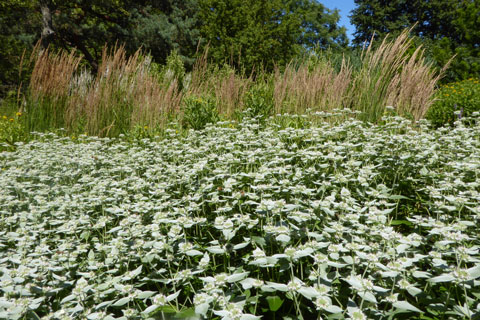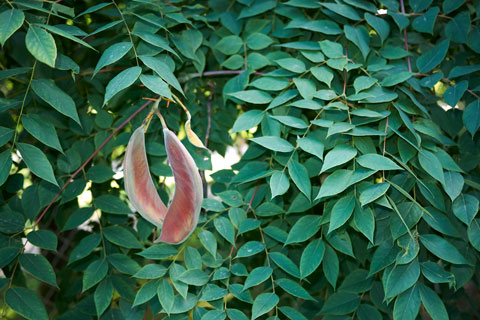5/1/2024
Urban Tough
Andrew Bunting

At the Pennsylvania Horticultural Society, most of our public gardens and landscapes are throughout Philadelphia, where the urban impacts on gardens and plants require us to think about plantings that can tolerate many urban conditions, such as poor soil, poor drainage, reflected heat, flooding at times and a multitude of human impacts. We’re always searching for those plants that have many seasons of interest, have myriad of ecological functions, and are resilient and urban tough.
Pictured: Pycnanthemum muticum is an excellent pollinator attractor and spreader in the landscape.
Tough Trees
Urban settings across the United States experience heat island effects, resulting in a need to develop tree canopy. Some neighborhoods in Philadelphia have a tree canopy of less than 2%, while an ideal tree canopy for a city is 25% to 35% coverage. The same is true across many U.S. cities and tough trees are needed for these conditions. The following are the best-of-the-best.
From Chicagoland Grows, which is a partnership between the Morton Arboretum and the Chicago Botanic Garden, is an introduction of the London plane tree, Platanus x acerifolia Exclamation! This highly prized tree also received the Pennsylvania Horticultural Society Gold Medal Plant designation. It’s an upright selection, and like other plane trees, it can withstand poorly drained soils, as well as tolerate compaction and high alkalinity. It’s fast growing and has large leaves, making it a great tree to create good shade in a short amount of time.
Quercus bicolor, the swamp white oak, is one of the most urban tolerant of all the oaks. In its youth, it has a broadly pyramidal habit, and over time will be more upright and can reach up to 100-ft. tall at maturity. The leaves turn yellow in the fall. As the common name implies, it can tolerate wet or swamp-like conditions. As Doug Tallamy outlines in his popular book, “Bringing Nature Home,” many of the native oak species—including white oak (Quercus alba) and the swamp white oak—are the host for hundreds of native species of caterpillars, insects and native birds.
In recent years, the Kentucky coffeetree (Gymnocladus dioicus) has become an increasingly popular street tree. Throughout the East Coast and Midwest this native legume is tolerant of an amazing host of urban conditions. While it can be gangly in its youth, it’ll develop into a fast-growing and upright tree. The fruits or pods of this tree can be messy, so selecting a male cultivar such as Espresso is suggested.
Great Grasses
For the urban landscape, many ornamental grasses seem to thrive in these harsh conditions. The native switch grass Panicum virgatum makes an impactful statement when grown in large masses. It’s characterized by clumps of upright narrow leaves with dense airy clusters of flowers and then seeds, which can provide considerable winter interest. Cape Breeze is a short and dense selection from Martha’s Vineyard, which is also salt tolerant. Heavy Metal has upright glaucous blue leaves and reaches 5-ft. tall. Northwind is very upright and reaches 4.5-ft. tall. In the fall the leaves turn a bright golden yellow and in 2014 it received the Perennial Plant of the Year recognition from the Perennial Plant Association.
The prairie dropseed Sporobolus heterolepis is a clump-forming grass that reaches 2.5-ft. tall with air sprays of flower heads in the summer. The fragrance of the flower has been described as smelling like “buttered popcorn” or having a cilantro-like fragrance. This is one of the few ornamental grasses tolerant of dry soils and wet conditions.
New to the market is the prairie native big bluestem, Andropogon gerardii Blackhawks. This introduction from noted perennial plant breeder Brent Horvath at Intrinsic Perennials, has arching leaves and upright stems that are an amazing dark purple, which is a great backdrop for many of the native asters.
Ecological Functions
Plants with ecological functions are those that support wildlife in the garden. This could be plants that are abundant in seeds and fruits that provide a food source for birds and mammals, or the myriad of plants that are a host to pollinating insects and birds or are a host for the larval caterpillar form of moths and butterflies to feed. Many of these plants, in addition to being highly ornamental in the landscape and having ecological functions, are also tolerant of many urban conditions.
 Pictured: The seeds of Kentucky coffeetree, Gymnocladus dioicus.
Pictured: The seeds of Kentucky coffeetree, Gymnocladus dioicus.
The giant coneflower Rudbeckia maxima has broad basal leaves that are bluish green. Its towering stems reach almost 8-ft. tall, producing coneflower-like flowers with yellow petals and a center black “cone” that’s filled with edible seeds. This is a great native plant and food source for many seed-eating birds, especially the American Goldfinch. Other great seed sources include the coneflowers (Echinacea purpurea) and many rudbeckias, including Goldsturm and American Gold Rush.
There are many great pollinator-attracting plants for the urban garden and landscape. Spreading and colonizing plants can play an especially important role in the landscape, given that they can quickly cover the ground, making impactful displays. There are many species of native mountain mints, however, Pycnanthemum muticum is the best for its ability to quickly expand in a short amount of time. Growing to 2-ft. tall, it’s covered in attractive white bracts and tiny lavender flowers. The flowers attract an amazing myriad of pollinating bees, wasps and other native pollinating insects. Because it’s in the mint family, it’s also resistant to deer browsing.
Another great colonizing plant is the giant hyssop (agastache). Like the mountain mint, it’s also in the mint family and has fragrant foliage that wards off deer. There are several outstanding cultivars—including Blue Boa, Black Adder and Blue Fortune—which are excellent perennials for attracting many different pollinators.
For early spring interest, the native Packera aurea (golden ragwort) spreads quickly in the garden. Tufts of basal leaves support wiry stems covered in a profusion of small, yellow, daisy-like flowers. It can also tolerate shade.
Urban conditions require gardeners to select plants and trees that are urban tough enough to withstand difficult soil and drainage conditions, as well as human impacts like cars and foot traffic. Thankfully, there are lots of plants and trees widely available at garden and nursery centers that provide the resilient qualities needed to thrive in an urban setting, while also adding significant ornamental, shade cover and ecologic function to the landscape. GP
Andrew Bunting is the Vice President of Horticulture for the Pennsylvania Horticultural Society (PHS), which uses horticulture to advance the health and well-being of the Greater Philadelphia region. To learn more about PHS or to become a member and support greening initiatives in over
250 neighborhoods, visit PHSonline.org.